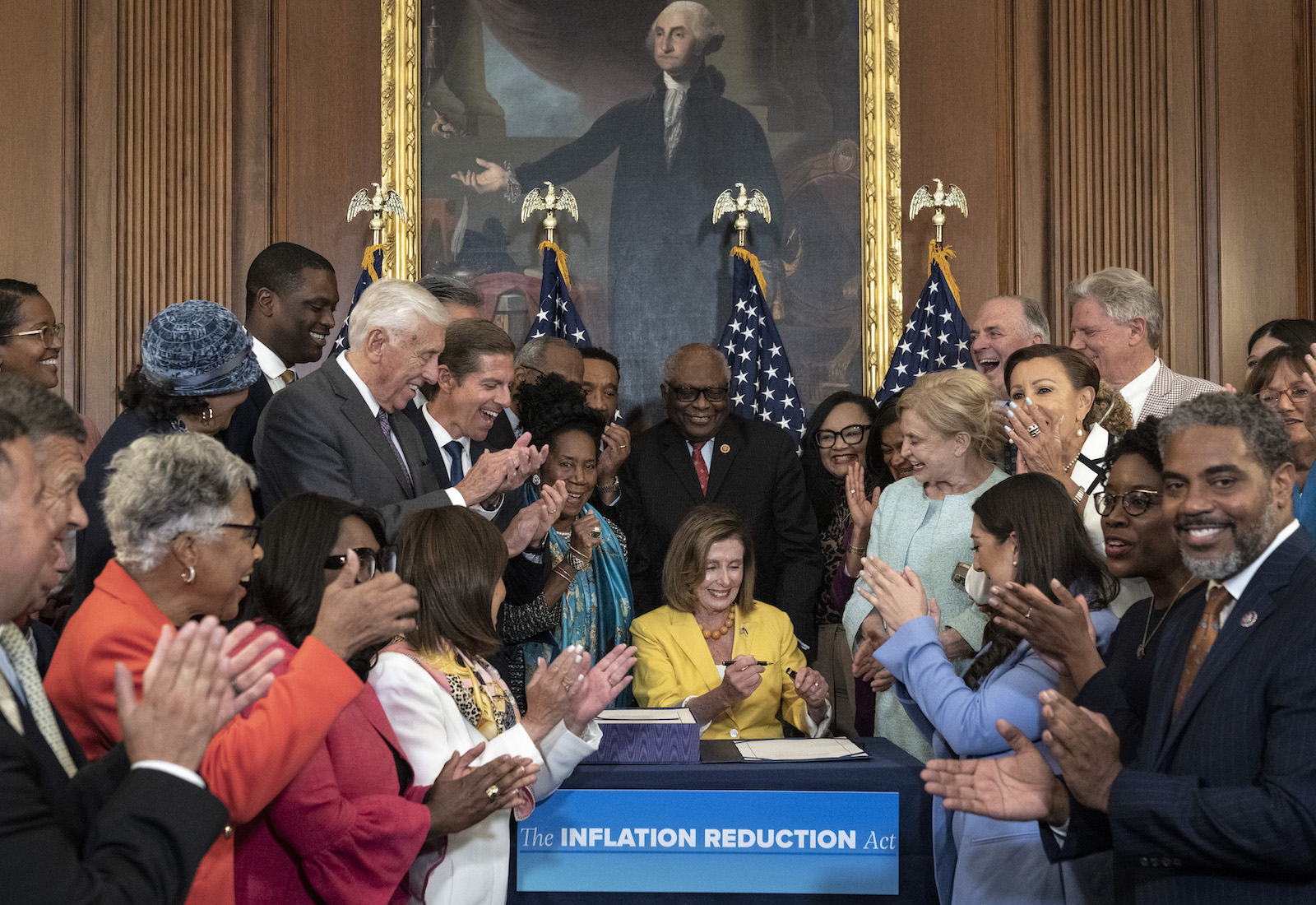When Joe Biden first became president, some found it hard to believe that he cared very much about climate change.
With a global pandemic raging, the former vice president and longtime senator pitched his 2020 campaign as a return to normalcy and a referendum on the erratic leadership of Donald Trump. His campaign pledges to ban drilling on federal lands and spend trillions of dollars to decarbonize the economy — though they amounted to among the most ambitious climate agenda ever put forward by a major-party candidate — were widely seen as consolation prizes to skeptical progressives and climate hawks, like those who had backed Senator Bernie Sanders or former Washington Governor Jay Inslee in the 2020 Democratic primaries.
It’s clear now that these skeptics underestimated the outgoing president. Biden’s climate agenda, broader and more ambitious than that of any U.S. president before him, is poised to stand as the most consequential feat of his presidency, especially given his self-evident failure to “heal the soul of the nation” by ushering it into a post-Trump era. He succeeded in getting Congress to pass the Inflation Reduction Act, or IRA, a misleadingly titled law that amounts to an unprecedented subsidy for renewable energy and climate-friendly technologies like electric vehicles. The measure triggered a wave of investment that has begun to reshape the nation’s economy and finally put the U.S. within reach of its commitments under the 2015 Paris Agreement.
“I think Biden will go down in history as passing the biggest climate bill that was ever passed in the world’s history,” said Sean Casten, a Democratic member of Congress from Illinois (and former contributor to Grist).
If Biden’s presidency represents a major step forward in the climate fight, though, it is also a cautionary tale about the limits of climate policy in the United States. The success of the IRA shows that a massive clean energy push is politically viable, under the right circumstances. (Whether or not it’s politically advantageous, or even prudent, is a story that the 2024 election called into question.) But Biden’s attempts to restrict fossil fuel production throughout his presidency were far less successful — not only did his push to curb oil and natural gas production get mired in litigation before it could bear any real fruit, but it also generated political backlash that never really dissipated.
It’s too early to tell whether Biden’s comprehensive climate policy — feeding renewable energy with the proverbial carrot and punishing fossil fuels with the stick, essentially — is a historical anomaly or a preview of how future Democratic administrations might tackle the issue. An even more fraught question is whether Biden’s renewable energy victory will prove durable. Even though Biden revolutionized U.S. climate policy, the public was barely aware that he did anything at all on the issue. Donald Trump now has four years to claw that progress back.
Biden took office at a moment when passing a Green New Deal-inspired climate plan seemed almost feasible: Democrats controlled both the Senate and the House of Representatives, and the upheavals of the COVID-19 pandemic had demonstrated a new appetite for massive government spending to kickstart the economy, as demonstrated by the $1.9 trillion American Rescue Plan that passed early in Biden’s term.
This was the political environment that gave birth to “Build Back Better,” a governing agenda that encompassed all the major legislative priorities that the Democratic Party had developed since the first Barack Obama administration. Months of public and private haggling within the Democratic party ensued. In the end, the only progressive priority that survived in anything close to its fullest form was climate change.
This surely has something to do with the fact that concern about climate change has only grown since Democrats’ first efforts to pass a major climate bill in 2010 — and the fact that activists like those in the Sunrise Movement staged dramatic demonstrations that kept the issue at the top of the party’s agenda. Still, to this day nobody can say for sure why the Democrats of 2022 ended up passing a pathbreaking climate bill rather than, say, the “care economy” proposals that were another major pillar of Build Back Better.
By many accounts, it was the war in Ukraine, which exposed the dangers of global reliance on Russian natural gas, that launched energy to the top of Democrats’ agenda. Suddenly, diversifying the country’s energy sources to include more wind, solar, and geothermal energy, along with increased battery storage, was something that all 50 Democratic senators could theoretically agree on — even the party’s most conservative member, West Virginia Senator Joe Manchin, who’d once released a campaign ad in which he fired a rifle at the party’s Obama-era climate change bill.
“Joe Manchin clearly believed in this,” said Josh Freed, senior vice president for climate and energy at the think tank Third Way. “He could have walked away at any point.”
But nothing — not Manchin’s willingness to play ball, not the war in Ukraine, and certainly not any clamoring from Biden’s 2020 majority — can fully explain what inspired the party to tackle climate change head-on. In the view of Casten, the Democratic representative from Illinois, the IRA got done thanks to the unsung work of a humble House committee.
In 2019, after Democrats took control of the House of Representatives for the first time in eight years, Speaker of the House Nancy Pelosi revived a committee that hadn’t existed since the chamber’s failed efforts to tackle climate change in the Obama years. The Select Committee on the Climate Crisis, Pelosi told The New York Times in 2018, would “prepare the way with evidence” for future climate legislation. In 2020, months before Trump left the White House, committee chair Kathy Castor, a representative from Florida, and her colleagues (including Casten) released a 500-page smorgasbord of recommendations that a future president could use to develop a climate agenda. Unlike prior reports from the first iteration of the committee, which focused on making carbon emissions more costly, this report was chock-full of incentives that could entice energy utilities and American homeowners alike to adopt clean energy.
“We relied almost exclusively on carrots rather than sticks,” Casten said. “Pelosi’s skill in holding all factions of the Democratic House together and figuring out how to get both the infrastructure bill and the climate bill done is really why that stuff survived.
“Kathy gave her the recipe, and Pelosi did the cooking,” Casten added.

Drew Angerer / Getty Images
But Biden’s team knew that they had a limited window of time to turn this long-awaited policy platter into a bill that the Senate could pass and the president could sign. According to White House Climate Advisor Ali Zaidi, in his meetings with congressional leaders Biden insisted that climate and energy provisions remain at the center of Build Back Better. The result was the IRA.
“Every single time, he brought up the importance of carrying forward climate and clean energy,” Zaidi told Grist.
Now, as incoming president Donald Trump prepares to take a hatchet to the nation’s environmental policies for a second time, the power of the IRA is beginning to come into view. The climate component of the bill revolves around incentives that encourage households, businesses, state governments, and even school districts to adopt clean energy and reduce emissions. These were specifically designed to have political resilience: States and private parties don’t often turn down free money or readily pass up the opportunity for more economic development. If Trump tries to repeal Biden’s clean energy tax credits, the thinking is that he’ll run into opposition from members of his own party, who have constituents that are starting to feel the benefits of Biden-era investments in their communities.
According to projections from the Rhodium Group, a leading climate research firm, the IRA will reduce U.S. carbon emissions by up to 42 percent from its peak levels. While this assessment assumes cooperation from banks, corporations, and even oil companies, most other projections agree that the law will put the U.S. within striking distance of Biden’s goal of halving emissions by the end of this decade.
But the IRA only accomplishes the first part of what most climate advocates believe is supposed to be a two-step process: Entice decarbonization with incentives, punish carbon intensity with rules and regulations. Dangle the carrot, beat with the stick.
The passage of the IRA was a tremendous political feat. But all the while, the Biden administration’s other climate efforts were starting to run aground.
Even as climate hawks celebrated the passage of the IRA, the United States was on the brink of becoming the world’s largest-ever producer of fossil fuels, pulling almost enough crude oil out of the ground each day to supply all of Europe. The technological advances of the fracking boom had allowed drillers to more than double production of both oil and natural gas since 2010, and oil became a key part of the nation’s trade balance after President Obama lifted a long-standing ban on crude oil exports in 2015.
Biden’s main attempt to stem this massive tide was through an unambiguous campaign promise: “no new drilling on federal lands, period.” Though federal lands and waters account for only around a quarter of U.S. oil production, and around 10 percent of natural gas production, Biden’s pledge sent a clear signal: He was going to use the biggest tool available to the president to slow the growth of U.S. fossil fuel production.
But this attempt to restrict fossil fuel supply met with far greater opposition than the Inflation Reduction Act, and was far less successful. Just after taking office, Biden ordered the Interior Department, which manages federal lands and waters, to pause all new oil and gas lease sales pending a review of their climate impacts. This pause soon fell victim to a tangle of contradictory legal rulings around the scope of executive authority, an issue where courts have been happy to rein in presidential power. A federal court in Louisiana declared in early 2022 that the administration could not pause all lease sales, accepting a conservative argument that the executive branch was overreaching in its interpretation of federal law. But after the Interior Department held a lease sale, a separate court in Washington, D.C., ruled that the administration had erred in doing so without considering the climate impacts of increased oil production — boxing Biden in between contradictory mandates.
In the background, a post-pandemic spike in gasoline prices had changed the optics of Biden’s drilling pledge for the worse. While new drilling leases on federal lands have a negligible impact on gasoline prices — new leases wouldn’t produce new gas for the market for close to a decade — Republicans and oil industry figures slammed the administration at every opportunity for what Wyoming Senator John Barasso called “attack[ing] American energy.” The attacks seemed to stick. By the time Biden and Manchin negotiated the IRA in 2022, the anti-oil position had become a political loser, and Manchin was able to negotiate a provision in the climate law requiring new lease sales on federal lands and in the Gulf of Mexico.
The legal ping-pong continued after the IRA passed. With its hand finally forced by the courts in December 2023, the Interior Department held a large lease sale on a block of offshore waters that had been tied up in litigation for the better part of a decade. The sale drew almost $400 million in bids from oil majors like Hess, Occidental, and Shell, in what was the highest-grossing lease sale since before the pandemic. If there had been any doubt, Biden’s campaign pledge was officially dead.
The culmination of the Biden administration’s turnabout on fossil fuel production, and the decision that generated the greatest furor among climate activists, was the Interior Department’s March 2023 approval of the Willow oil project on the North Slope of Alaska. Former Vice President Al Gore called the approval “recklessly irresponsible”: Burning the 600 million barrels of oil that ConocoPhillips plans to produce from the project is poised to add the equivalent of 2 million cars’ worth of carbon dioxide to the air. Nevertheless, the final decision to approve the project reportedly came from the White House itself. Facing spiking gasoline prices at home and global upheavals in the oil market — plus the specter of lawsuits from ConocoPhillips, which had started the project well before Biden came on the scene — administration officials no longer appeared willing to try to meaningfully slow down the future rate of U.S. oil production.
Earlier this month, in the waning days of his administration, Biden revived the long-dormant lease issue, announcing that he would prohibit future oil drilling on more than 600 million acres of ocean territory on both coasts. The move drew praise from environmental advocates, and it would be hard for Trump or future presidents to undo — but it is largely symbolic, and won’t fundamentally change the trajectory of the oil industry. The shoreline sections that Biden has protected have never drawn much interest from drillers, and even Trump backed off a pledge to open them up for oil production during his first term. In the geographies where it matters, like the crude-rich Gulf of Mexico, the fight was long since over.
In the battle over oil leases, the Biden administration learned the hard way that it’s very difficult to restrict fossil fuel production, especially with high gas prices and a hostile court system. Last year, as the election approached, the administration had to learn another bruising lesson: Even if you do restrict fossil fuel production, it’s hard to know how much you’re influencing the climate fight. This lesson came during a political squabble over the export of liquefied natural gas, or LNG.
In the decade since the fracking boom, natural gas companies have built several huge facilities along the Gulf Coast that condense and export fracked gas to China and the European Union. Proponents of the industry argue that it helps the climate and national security by weaning other countries off coal (which emits about twice as much carbon per unit of energy produced) and Russian gas, respectively. But activists have come out in force against the industry in recent years, arguing that LNG exports encourage other countries to build out gas-dependent power rather than renewable energy.
In January of last year, young climate activists led a social media campaign urging the Biden administration to reject a permit for one of the largest proposed LNG export facilities. This campaign caught the attention of White House climate advisors Ali Zaidi and John Podesta, who believed they needed to win back young climate-engaged voters as the president’s reelection campaign approached. The Department of Energy controls export authorization for natural gas facilities, and the Biden administration soon announced a moratorium on new export permits for LNG, pending a study on whether they were in the “public interest.” This move drew support from studies showing that gas exports raise domestic energy prices and that methane leakage along the gas supply chain may make them more emissions-intensive than even the coal power that they replace in the best-case scenario.
Yet again, conservatives and oil industry figures seized on the move as evidence of a Green New Deal agenda and pilloried Biden for it, with a group of red-state leaders calling it evidence of a “reckless environmental agenda.” A coalition of Republican attorneys general sued to stop the pause, and a conservative judge ruled in their favor within a few months. The pause was dead, and very few supporters or detractors appeared to even notice.
But the move did appear to push oil-industry heavyweights even further toward the Trump campaign: A few months after the administration announced the pause, several industry leaders reportedly discussed it with Trump during a now-infamous summit at Mar-a-Lago at which Trump pressed the leaders for campaign contributions in exchange for a friendly agenda. (They ended up giving him around $75 million.)
By the time the election arrived, it became clear that the administration saw these supply-side efforts to limit U.S. fossil fuel production as a political liability rather than an asset. When Biden dropped out and Kamala Harris became the Democratic nominee, she touted the fact that the U.S. has produced a record amount of oil and gas in recent years, and reversed her prior position in favor of banning fracking in an unsuccessful attempt to win over swing voters in Pennsylvania. Trump, meanwhile, attacked the natural gas export pause as “Kamala’s ban.”
The controversy over LNG unfolded in spite of the fact that the climate impact of the policy was never clear. There is a large body of conflicting research about whether LNG exports, which are often used to replace coal plants in developing countries, increase or decrease emissions relative to an identical world without them. The answer depends on how much methane you think is leaking from U.S. gas fields (this depends where you are and whom you ask), as well as on shifting domestic energy policies in importing nations like China and Vietnam. Indeed, reputable studies reach opposite conclusions, sometimes on the very same day, about whether LNG will help the climate by displacing coal power or harm it by displacing renewables.

Courtesy of John Allaire
Even after Trump won the 2024 election, the Biden administration hurried to finish its “public interest” study. This gave activists some tentative optimism: If Biden released a study finding that LNG exports raise energy prices or harm the climate, it might make it harder for the Trump administration to approve future terminals.
But the study the Energy Department ended up releasing was largely symbolic. While the department said that “unfettered” gas exports would be “neither sustainable nor advisable” and found that new exports would likely lead to more carbon emissions worldwide, it did not issue any concrete recommendations to guide future policy and stopped short of calling for a halt to new export approvals.
Most devastating of all for proponents of the LNG pause, the long-awaited study noted that the United States has already approved enough LNG capacity to meet global demand through the middle of the century, ensuring the country will remain a gas powerhouse regardless of what future administrations do. After years of campaigning, activists had succeeded in pushing the Biden administration to act on LNG. But by the time the administration made a move, it was already too late.
There is one objective metric by which Biden’s climate policy can be judged: the Paris Agreement, which vows to hold global temperature increases to less than 2 degrees Celsius. In order to help the world meet that agreement, the United States needs to cut its emissions by more than half relative to its 2005 levels.
Assuming Trump doesn’t gut the Inflation Reduction Act — a real possibility, but far from a certainty in a nearly evenly split Congress — Biden’s signature bill will get the United States a great deal of the way toward meeting that goal. But the country is still falling short, and time is running out.
Biden showed that “carrot” climate policy is both politically possible and effective at slowing down climate change — but he failed to create the same roadmap for “stick” policies to curb the expansion of fossil fuels. The president’s losses on oil leases and LNG were significant, because they were some of the few short-term actions Biden could have taken to restrict fossil fuels.
While the administration did also push several ambitious climate rules through the Environmental Protection Agency, including regulations that would eliminate power plant pollution and force a wholesale transition away from gasoline-powered vehicles, those high-profile moves are unlikely to bear fruit anytime soon. Designing the rules took almost the entire four years of Biden’s term, and they have yet to come into effect; the gas-powered vehicles rule, for instance, applies to cars of model year 2027 and later. Repealing the IRA requires help from Congress, but the incoming administration has the authority to unwind those rules on its own, and Trump reportedly wants to start doing so on day one.

Jeff Kowalsky / AFP via Getty Images
These defeats appear to have led to some soul-searching within the administration. When Zaidi, the White House Climate Advisor, reflected on Biden’s legacy in a press gaggle at last year’s United Nations climate conference, he questioned whether fossil fuel-restricting policies would ever be politically viable, though he hinted that future policy might have to try them anyway.
“I don’t think there is social license for a decarbonization playbook that puts upward price pressure for consumers in the marketplace,” Zaidi said. However, not everyone agrees. Jay Inslee, who passed a carbon tax as governor of Washington and then defended that tax against a repeal effort, says voters can get behind fossil fuel disincentives if they benefit from those policies.
“We tested that question [of support for a carbon tax], and it was not a narrow thing,” he said. “We emphasized what you’re getting for these investments, and people by thunderous applause accepted it.” (It helps that Washington state has not elected a Republican to statewide office since 2017.)
An even more urgent question is whether Biden’s carrots will themselves endure. From inside the Beltway, the IRA looked like a political miracle, and it is popular with Republican officials like Georgia Governor Brian Kemp — Georgia has seen more than $10 billion in investment from the IRA, resulting in almost 40,000 new jobs — but it has had a negligible impact on voters so far. In 2023, nearly a year after the bill had passed, a majority of voters thought it was still being considered or that lawmakers had given up on it — or didn’t know that such a bill had existed at all. This year, fewer than 3 in 10 voters said they thought the IRA had improved their lives. The 2024 election featured remarkably little discussion about Biden’s signature achievement at all.
The issue may be one of scope. A truly successful climate policy would do nothing less than reshape the world economy — a tall order for an administration with four years and a slim legislative majority. The IRA, with its big bets on a wide array of both proven and new decarbonization technologies, may still succeed in this. But we won’t know until it’s too late for anyone to take credit for it.
“Long-term policy doesn’t have immediate impact,” said Freed, of the think tank Third Way. “Rising wages, better standards of living, better opportunities for communities were always going to take longer than one election cycle to be visible. They didn’t happen physically in communities quickly enough to shift voter perception.”
As Biden prepares to leave office, he will have to contend with the fact that voters may finally begin to feel the benefits of his signature law when Trump is in office — and that they may ascribe those improvements to Trump’s policies, rather than his own. Biden will have to bear that cross, Freed said.
“If our goal is to have clean energy [that is] durable and pervasive — and people start seeing the benefits in their communities and it makes them more amenable to clean energy and demand more — that’s a good thing,” he said. “The positive impacts of clean energy and decarbonization need to be able to transcend elections and partisan politics.”
Source link
Jake Bittle grist.org





